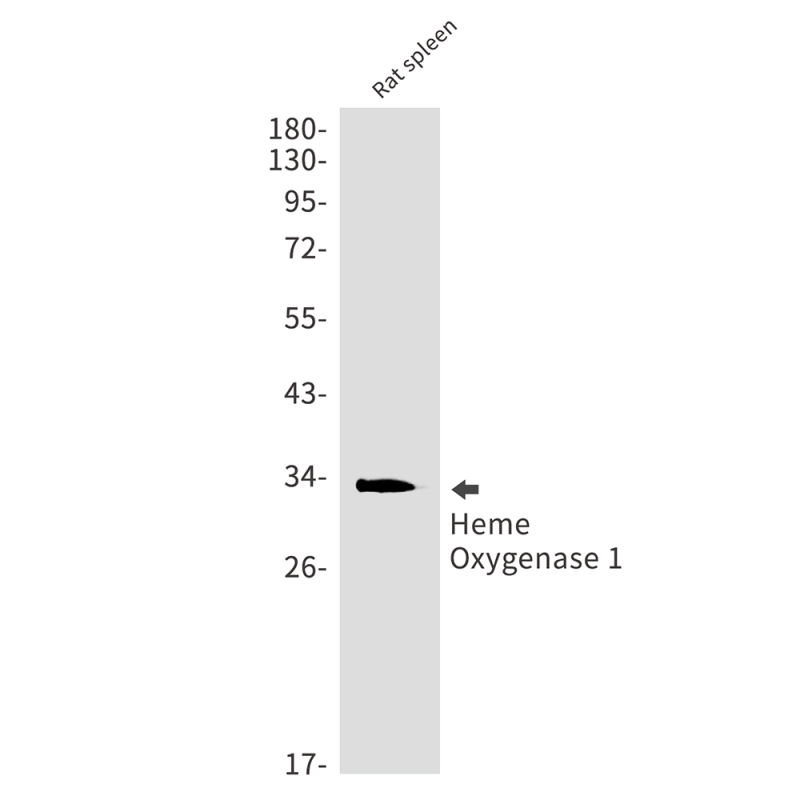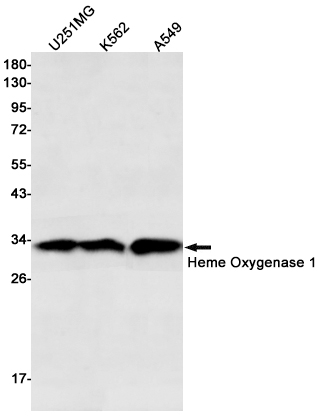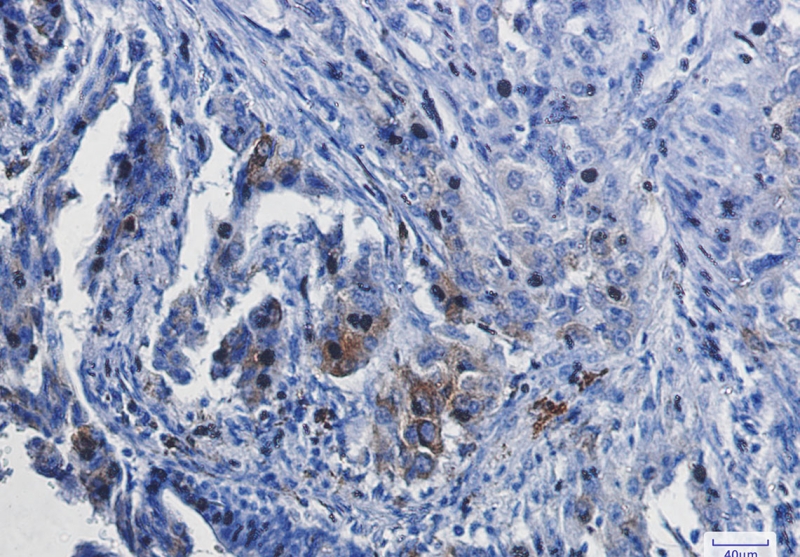



| WB | 1/500-1/1000 | Human,Mouse,Rat |
| IF | 1/20 | Human,Mouse,Rat |
| IHC | 1/50-1/100 | Human,Mouse,Rat |
| ICC | 1/50-1/200 | Human,Mouse,Rat |
| FCM | 咨询技术 | Human,Mouse,Rat |
| Elisa | 咨询技术 | Human,Mouse,Rat |
| Aliases | HO-1; HSP32; HMOX1; ; HO1 |
| Entrez GeneID | 3162 |
| WB Predicted band size | Calculated MW: 33 kDa; Observed MW: 33 kDa |
| Host/Isotype | Rabbit IgG |
| Antibody Type | Primary antibody |
| Storage | Store at 4°C short term. Aliquot and store at -20°C long term. Avoid freeze/thaw cycles. |
| Species Reactivity | Human,Mouse,Rat |
| Immunogen | Recombinant protein of Heme Oxygenase 1 |
| Formulation | Purified antibody in TBS with 0.05% sodium azide,0.05%BSA and 50% glycerol. |
+ +
1. **"Heme oxygenase: function, multiplicity, regulatory mechanisms, and clinical applications"** by Maines, M.D. (1992)
- 该综述讨论了血红素氧合酶1(HO-1)的生物学功能、调控机制及其在氧化应激和炎症中的保护作用,提及HO-1抗体在研究其表达调控中的关键应用。
2. **"Reduced stress defense in heme oxygenase 1-deficient cells"** by Poss, K.D. and Tonegawa, S. (1997)
- 研究利用HO-1基因敲除小鼠模型,通过HO-1抗体验证蛋白缺失,发现HO-1缺失导致细胞对氧化损伤的敏感性显著增加。
3. **"Heme oxygenase-1: from biology to therapeutic potential"** by Otterbein, L.E. et al. (2003)
- 该文献总结了HO-1的抗炎、抗氧化及细胞保护功能,并强调通过HO-1抗体检测其在疾病模型(如缺血再灌注损伤)中的表达上调。
4. **"Protective role of heme oxygenase-1 in cardiovascular diseases"** by Chen, Y. et al. (2019)
- 研究利用HO-1抗体进行组织免疫组化及Western blot分析,证明HO-1在动脉粥样硬化和心肌梗死中的心血管保护作用机制。
(注:以上文献信息为示例性概括,具体内容需参考原文。)
Heme oxygenase 1 (HO-1), encoded by the *HMOX1* gene, is a stress-inducible enzyme critical for heme catabolism. It catalyzes the breakdown of heme into carbon monoxide (CO), free iron, and biliverdin, which is subsequently converted to bilirubin. HO-1 plays a pivotal role in cellular defense mechanisms, exhibiting antioxidant, anti-inflammatory, and cytoprotective properties. Its expression is upregulated under oxidative stress, inflammation, hypoxia, and exposure to heavy metals or other toxins, mediated primarily through the Nrf2/ARE signaling pathway.
HO-1 antibodies are essential tools for studying the enzyme's expression, localization, and regulatory roles in various physiological and pathological contexts. These antibodies are widely used in techniques like Western blotting, immunohistochemistry (IHC), immunofluorescence (IF), and ELISA to detect HO-1 protein levels in tissues or cultured cells. Monoclonal antibodies offer high specificity, while polyclonal variants may provide greater sensitivity, though cross-reactivity risks require validation. Species reactivity typically includes human, mouse, and rat samples.
Researchers employ HO-1 antibodies to investigate conditions such as neurodegenerative diseases, cardiovascular disorders, cancer, and metabolic syndromes, where HO-1 modulation shows therapeutic potential. Proper validation using knockout controls or peptide blocking experiments is crucial to confirm antibody specificity, particularly given potential cross-reactivity with HO-2. a constitutive isoform. Commercial HO-1 antibodies often specify recognized epitopes, aiding experimental design for distinguishing isoforms or post-translationally modified forms.
×